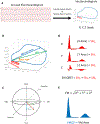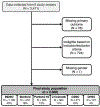Competing risks in patients with primary prevention implantable cardioverter-defibrillators: Global Electrical Heterogeneity and Clinical Outcomes study
- PMID: 33684549
- PMCID: PMC8169548
- DOI: 10.1016/j.hrthm.2021.03.006
Competing risks in patients with primary prevention implantable cardioverter-defibrillators: Global Electrical Heterogeneity and Clinical Outcomes study
Abstract
Background: Global electrical heterogeneity (GEH) is associated with sudden cardiac death in the general population. Its utility in patients with systolic heart failure who are candidates for primary prevention (PP) implantable cardioverter-defibrillators (ICDs) is unclear.
Objective: The purpose of this study was to investigate whether GEH is associated with sustained ventricular tachycardia/ventricular fibrillation leading to appropriate ICD therapies in patients with heart failure and PP ICDs.
Methods: We conducted a multicenter retrospective cohort study. GEH was measured by spatial ventricular gradient (SVG) direction (azimuth and elevation) and magnitude, QRS-T angle, and sum absolute QRST integral on preimplant 12-lead electrocardiograms. Survival analysis using cause-specific hazard functions compared the strength of associations with 2 competing outcomes: sustained ventricular tachycardia/ventricular fibrillation leading to appropriate ICD therapies and all-cause death without appropriate ICD therapies.
Results: We analyzed 2668 patients (mean age 63 ± 12 years; 624 (23%) female; 78% white; 43% nonischemic cardiomyopathy; left ventricular ejection fraction 28% ± 11% from 6 academic medical centers). After adjustment for demographic, clinical, device, and traditional electrocardiographic characteristics, SVG elevation (hazard ratio [HR] per 1SD 1.14; 95% confidence interval [CI] 1.04-1.25; P = .004), SVG azimuth (HR per 1SD 1.12; 95% CI 1.01-1.24; P = .039), SVG magnitude (HR per 1SD 0.75; 95% CI 0.66-0.85; P < .0001), and QRS-T angle (HR per 1SD 1.21; 95% CI 1.08-1.36; P = .001) were associated with appropriate ICD therapies. Sum absolute QRST integral had different associations in infarct-related cardiomyopathy (HR 1.29; 95% CI 1.04-1.60) and nonischemic cardiomyopathy (HR 0.78; 95% CI 0.62-0.96) (Pinteraction = .022).
Conclusion: In patients with PP ICDs, GEH is independently associated with appropriate ICD therapies. The SVG vector points in distinctly different directions in patients with 2 competing outcomes.
Keywords: Competing risk; Global electrical heterogeneity; Heart failure; Implantable cardioverter-defibrillators; Ventricular tachycardia/Ventricular fibrillation.
Copyright © 2021 Heart Rhythm Society. Published by Elsevier Inc. All rights reserved.
Figures





Similar articles
-
Improving sudden cardiac death risk stratification by evaluating electrocardiographic measures of global electrical heterogeneity and clinical outcomes among patients with implantable cardioverter-defibrillators: rationale and design for a retrospective, multicenter, cohort study.J Interv Card Electrophysiol. 2018 Jun;52(1):77-89. doi: 10.1007/s10840-018-0342-2. Epub 2018 Mar 14. J Interv Card Electrophysiol. 2018. PMID: 29541969 Free PMC article.
-
Competing risks of monomorphic vs. non-monomorphic ventricular arrhythmias in primary prevention implantable cardioverter-defibrillator recipients: Global Electrical Heterogeneity and Clinical Outcomes (GEHCO) study.Europace. 2024 Jun 3;26(6):euae127. doi: 10.1093/europace/euae127. Europace. 2024. PMID: 38703375 Free PMC article.
-
Primary prevention implantable cardioverter-defibrillators in hypertrophic cardiomyopathy-Are there predictors of appropriate therapy?Heart Rhythm. 2021 Jan;18(1):63-70. doi: 10.1016/j.hrthm.2020.08.009. Epub 2020 Aug 12. Heart Rhythm. 2021. PMID: 32800967
-
Systematic Review for the 2017 AHA/ACC/HRS Guideline for Management of Patients With Ventricular Arrhythmias and the Prevention of Sudden Cardiac Death: A Report of the American College of Cardiology/American Heart Association Task Force on Clinical Practice Guidelines and the Heart Rhythm Society.J Am Coll Cardiol. 2018 Oct 2;72(14):1653-1676. doi: 10.1016/j.jacc.2017.10.052. Epub 2017 Oct 30. J Am Coll Cardiol. 2018. PMID: 29097297
-
Evolution of risk stratification and sudden death prevention in hypertrophic cardiomyopathy: Twenty years with the implantable cardioverter-defibrillator.Heart Rhythm. 2021 Jun;18(6):1012-1023. doi: 10.1016/j.hrthm.2021.01.019. Epub 2021 Jan 26. Heart Rhythm. 2021. PMID: 33508516 Review.
Cited by
-
The role of metabolic syndrome in sudden cardiac death risk: Recent evidence and future directions.Eur J Clin Invest. 2022 Feb;52(2):e13693. doi: 10.1111/eci.13693. Epub 2021 Nov 8. Eur J Clin Invest. 2022. PMID: 34714544 Free PMC article. Review.
-
Electrocardiographic risk stratification in patients with a primary prophylactic implantable cardioverter defibrillator: can future arrhythmias correlating with sudden cardiac death be predicted?Europace. 2024 Jun 3;26(6):euae133. doi: 10.1093/europace/euae133. Europace. 2024. PMID: 38758091 Free PMC article.
-
Reproducibility of global electrical heterogeneity measurements on 12-lead ECG: The Multi-Ethnic Study of Atherosclerosis.J Electrocardiol. 2021 Nov-Dec;69:96-104. doi: 10.1016/j.jelectrocard.2021.09.014. Epub 2021 Oct 2. J Electrocardiol. 2021. PMID: 34626835 Free PMC article.
-
Detection and removal of pacing artifacts prior to automated analysis of 12-lead ECG.Comput Biol Med. 2021 Jun;133:104396. doi: 10.1016/j.compbiomed.2021.104396. Epub 2021 Apr 19. Comput Biol Med. 2021. PMID: 33872969 Free PMC article.
-
Genetic architecture of spatial electrical biomarkers for cardiac arrhythmia and relationship with cardiovascular disease.Nat Commun. 2023 Mar 14;14(1):1411. doi: 10.1038/s41467-023-36997-w. Nat Commun. 2023. PMID: 36918541 Free PMC article.
References
-
- Al-Khatib SM, Stevenson WG, Ackerman MJ, et al. 2017 AHA/ACC/HRS guideline for management of patients with ventricular arrhythmias and the prevention of sudden cardiac death: Executive summary: A Report of the American College of Cardiology/American Heart Association Task Force on Clinical Practice Guidelines and the Heart Rhythm Society. Heart Rhythm 2018;15:e190–e252. - PubMed
-
- Kober L, Thune JJ, Nielsen JC, et al. Defibrillator Implantation in Patients with Nonischemic Systolic Heart Failure. N Engl J Med 2016;375:1221–1230. - PubMed
-
- Burch GE, Abildskov JA, Cronvich JA. A Study of the Spatial Vectorcardiogram of the Ventricular Gradient. Circulation 1954;9:267–275. - PubMed
Publication types
MeSH terms
Grants and funding
LinkOut - more resources
Full Text Sources
Other Literature Sources
Medical
Miscellaneous

